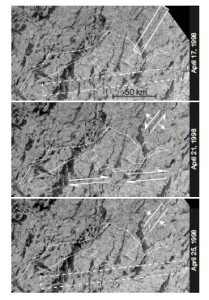Anisotropic sea ice mechanics
Alexander Wilchinsky, Daniel Feltham
Our aim is to develop a rheological model of sea ice based on a realistic description of underlying deformation processes: Coulombic shear rupture, ridging and tensile failure. While each of these failure mechanisms are relatively well understood on their own, understanding and simulating their combination in a general sea ice deformation is a challenge because they can occur in different orientations. In previous theoretical treatments, the orientations of such failures have been thought to occur arbitrarily, and the usual approach has been to use ad hoc plastic rheological models of sea ice. More recent satellite imagery (e.g., see Figure), however, shows that sea ice failure has preferential directions, and its previous deformation history, responsible for the presence of long, narrow areas of thin ice called leads, plays a crucial role in determining the sea ice mechanical response to external stresses.
Figure: An example of Coulombic and ridging failure of sea ice during the SHEBA experiment as seen from SAR images. The dates are given on the black margins. The white rectangles are placed over two slip lines, probably formed through a Coulombic failure in a lead and the floe ice. The upper failure occurs along an existing lead as is seen through its shear accompanied by dilatancy. After this, the lead ridges as is shown by the appeared white colour. The lower failure occurs in the isotropic ice (forming a slip line) and does not exist on the top plot; therefore it is shown there by a dashed rectangle. There is no visible dilatancy along the slip line. The images are provided by R. Kwok, Jet Propulsion Laboratory (RADARSAT-1 images copyright CSA 2011) and are available at www-radar.jpl.nasa.gov/rgps/ image\_files/combine\_small.gif.}
Accounting for the presence of oriented leads results in an anisotropic sea ice rheology. We have developed a rheological model of sea ice that allows:
- A realistic description of the sea ice state, through adoption of an orientation-dependent ice thickness distribution function;
- Identification of particular failure modes and their direction based on the sea ice state and the imposed stress; and
- Determination of the resultant deformation and change of thickness distribution of the sea ice cover.
To do this, we considered three failure modes: Coulombic (in-plane fracture failure), ridging (out-of-plane compressional failure and pile up) and tensile failure. The direction, and presence of a failure mode, is determined by the minimum stress necessary to attain it. The direction of the failure line then determines sea ice deformation, such as sliding along the Coulombic line, or contraction across the ridging failure lines.
References:
Wilchinsky, AV and Feltham, DL, Rheology of discrete failure regimes of sea ice, J. Physical Oceanography, in press.
Wilchinsky, AV, and DL Feltham, Modeling Coulombic failure of sea ice with leads, J. Geophysical Research, 116, doi:10.1029/2011JC007071, 13 pages, 2011.

